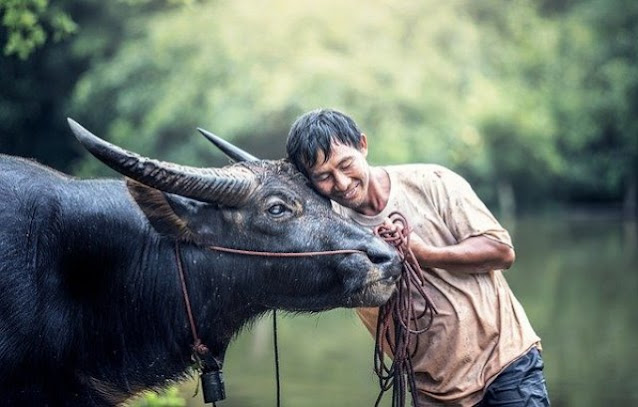Buffalo plays an important
role in farming economy of Asian, European, African, and Latin American
countries. Buffalo is being progressively known as an animal for milk, meat,
and draft amongst farm livestock. Despite contribution of buffalo for usage of many
purposes, this animal has not received desired attention for its care and
growth. Major hurdle in the enrichment of production potentials of buffaloes is inadequate research and
knowledge. However, many scientific researchers have been executed for care,
growth and development of cattle.
Water buffaloes are large animals
belonging to the Bovidae , which are a crucial livestock species in southern
Asia, also as in South America, southern Europe, and northern Africa. It is
estimated that there are approximate 158 million water ox in the world, 97% of
which inhabit tropical and subtropical parts of Asia. However, there a minimum
of one buffalo for every three heads of cattle.
The classification of the water ox
currently remains unresolved. Some researchers consider one species, water
buffalo , with three subspecies: swamp buffalo or carabao (Bu. bubalis
carabanesis), river buffalo (Bu. bubalis bubalis) and therefore wild water ox
or arni (Bu. bubalis arnee). Others consider these to be closely related, but
separate species. In 2003, the International Commission on Zoological
Nomenclature ruled in favor of classing the wild buffalo as a separate taxon.
As a result, the wild forms are now usually mentioned as Bu. arnee and the
domestic forms as Bu. bubalis. However, previous usage remains acceptable for
those authors who regard them as conspecific. Swamp buffalo and river buffalo
are believed to be derived from wild water ox due to products since thousands
of years in Asia. River buffalo consists of 50 chromosomes and swamp buffalo
has 48 chromosomes. Remaining two are not readily inter breed while fertile progeny
can happen.
Swamp buffalo are predictably raised for
draught purposes in paddy farming regions and; river buffalo are retained to
get fresh milk and ghee production. The animals are slaughtered for meat
consumption once they reach the top of their working lives and are often during
a poor condition when this happens. Male calves that aren't needed as
replacements aren't always used for meat production and therefore the surplus
stock are normally allowed to die from inanition. Water buffalo provides source
of meat in countries near Caspian and Black Seas, where these are slaughtered in
the age approximate 18 months having 300–360 kg live weight and dress out at
approximate 55%.
Buffalo account for about 80 million
metric plenty of milk and three million metric plenty of meat annually to world
food supplies, much of it in parts of the planet that are prone to nutritional
imbalances. In addition they're a serious source of draft power in much of the
undeveloped world, which is why buffalo are called the ‘live tractors of the
East’ (Cockrill, 1970). Therefore, it's surprising that little or no resources
and scientific effort have gone into developing superior buffalo breeds almost
like that of cattle, albeit there's abundant genetic variety of this species.
Sound breeding programs can also produce good quality milk.
Buffalo are the second largest source of
milk supply within the world. As per figures
of UN Food & Agriculture Organization (FAO) published during 2004, world
production of buffalo milk was 75.8 million metric tons. As per trends shown in
world, milk production volume of buffalo milk is increasing about 3% per year.
While dairy cow produce 84% of the entire milk within the world it's to be
noted that this volume is with a mean fat and protein content of 4% and 3.5%,
respectively (FAO, 2007). buffalo milk consists of about 7.5% to almost 9% fat,
while proteins content ranges from 4% to 4.5%. Thus, in terms of
energy-corrected milk, buffalo milk accounts for about twice the food
contribution suggested by the particular volume of buffalo milk produced
yearly.
Buffalo are less tolerant of extremes of
warmth and cold than most cattle breeds. Body temperature of buffalo is lower
than other cattle in spite of their black thick skin (three times thicker than
cow) absorbs the sun’s radiant heat energy very effectively. Skin of a buffalo
has only one-sixth density of sweat glands as compared to a cow. This is why
buffalo wish to wallow in water or mud pools when the temperature and humidity
are high. Maintenance of body temperature in this way impacts feed intake, milk
production and reproduction. Generally, dairy cow is considered to be suitable
in age of first calving i.e. 24-30 months. 12 to13 months should be calving
interval, with lactation length of 300 days, a 60–90 day dry period, and milk
production of between 6000 and 7000 kg per lactation. Comparing to buffalo with
their own species-specific productive and reproductive characters, a buffalo
heifer is on average around 40 to 60 months at first calving. Productive characters
can be developed through other selective breeding practices. Average calving
intervals is ranged between 15 to 18 months in India and Pakistan. Dry periods
have been observed from 90 to 150 days in Pakistani Nili-Ravi, and 60 to 200
days dry period is being reported in Murrah ranges. However, average lactation span
is ranged from 252 - 270 days. As a results of these factors the productive
lifetime of a dairy buffalo is merely 39% of its total life, compared to a
shocking 52% in developed modern dairy cattle breeds.
In buffalo milk-producing countries of
Asia, it's observed that there are large differences due to the season in
breeding and calving in buffalo. In India and Pakistan, 80% of the buffalo
calve during June and December, causing a decline in milk production from March
to June. Production starts in June and reaches at the highest around in
September-October before declining again. However, early summers weaken in milk
production due to heat stress and shortage of forage greens. Buffalo have
survival mechanisms to pursue water for involvement in these conditions, but
extreme heat and cold significantly affect their milk production and
reproductive efficiency. In addition to climatic influences, it is clear that
poor nutrition and management have an adverse effect on breeding and milk
production.
Changes in breeding, feeding and
management can cause notable improvements within the milk production and
reproductive performance of buffalo (Sastry et al., 1988). An obvious though
neglected target has been checking out why the primary calving occurs at such a
late age. Attention is required from birth to the time heifers reach breedable
body size could bring down the age of six to nine months. It has been shown
that balanced feeding could bring buffalo heifers into cycle once they reach
330 kg weight. It has also been observed that heifers have calved at 20 - 24
months. Calving intervals in buffalo are influenced by the irregular and silent
heat period also as some reported irregularities in reproductive hormones
throughout the year. Seasonal breeding in buffalo is observed due to diminished
sexual activity during Marchs and Junes. However, these animals are believed to
be seasonal breeders, it's also been reported that they will breed throughout
the year if reproduction management is sweet. Thus, it seems clear that there
are several important management factors to think about so as to enhance milk
production in buffalo including management of nutritional status of the dam
around calving, balanced feeding, good milking management throughout the year.
















0 Comments
Please do not enter any spam link in the comments box